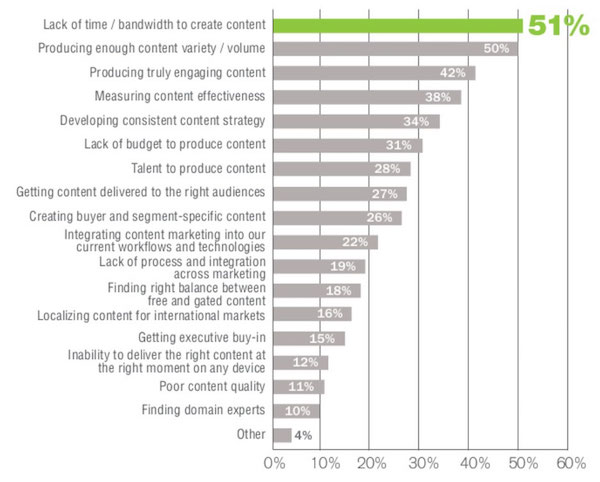How important is your content marketing strategy? CMOs at technology companies report that building up content marketing as an organizational competency is the second most important initiative, only behind measuring ROI. Yet 70% of marketers lack a consistent or integrated content strategy.
Even though most B2B marketing teams believe content marketing is critical, the majority of these teams find themselves challenged to meet their content marketing goals due to a lack of strategy.
If it is so critical then why would these teams and CMOs overlook content marketing strategy?
Probably because they have a ton of things that need to get done every day and not enough resources to do them. How many times have you gone into work planning to tackle that ultra important strategic project only to end up spending the day putting out fires?
Another reason might be because the more planning something takes, the more likely it ends up being put on the bottom of the to do list. Or maybe it’s because they have been burned before, after creating complex marketing plans with mediocre results.
That’s why I have outlined a B2B content marketing strategy that is easy to implement, lightweight and flexible. But don’t get me wrong, this framework is very effective. This content marketing strategy was purposely designed to meet the challenges that today’s B2B marketing organizations face.
B2B Content Marketing Strategy Challenges
Before you can determine how to solve your content marketing challenges and gain more qualified leads from that content, you first need to understand the root cause of your challenges. When B2B companies want to improve their content marketing, they often look to consultants to help them create buyer’s journey maps, content audits, personas, or content calendars.
While these are valuable strategies, they don’t address the root B2B content marketing strategy challenges that most B2B companies face. If your biggest challenge is creating content, buyer’s journey maps, content audits, personas and content calendars aren’t going to solve that specific challenge.
It is akin to having a broken leg and hiring Usain Bolt’s trainer to get you running better. You aren’t running anywhere until you get that broken leg fixed, no matter how great your training program.
If that analogy is a bit too dramatic for you, think of it like this: how many times have you or someone you know set out to get into shape by signing up for a complicated exercise program, joining a gym or hiring a personal trainer, only to find yourself not showing up after a few weeks?
There is a very annoying commercial that comes on Hulu all the time selling an exercise app. In the ad there is a line where they say, “The hardest part about going to the gym is going to the gym!”
That phrase could easily be adapted to address the challenge most B2B marketing teams face: the hardest part about writing content is writing content! Buyer’s journey maps, an audit list of your content, personas, content calendars and most content marketing consultants aren’t going to jump on your keyboard and start typing.
The root cause of most B2B content marketing strategy challenges is that the marketing team is not creating enough content. A survey by the Content Marketing Institute and MarketingProfs found that the top four challenges B2B marketers cited were:
- Producing engaging content (54%)
- Producing content consistently (50%)
- Measuring content effectiveness (49%)
- Producing a variety of content (42%).
Another study by the LinkedIn Technology Marketing Community found that the top two content marketing challenges companies cited were:
- Lack of time/bandwidth to create content (51%)
- Producing enough content variety/volume (50%). (LinkedIn Technology Marketing Community)
Six of these top challenges are directly linked to challenges in creating content. Clearly the problem most marketing teams face is how to create more content. In the next few sections we will outline a lightweight iterative framework with step-by-step guidance on how to start consistently creating content.
A B2B Content Marketing Strategy That Works
A lightweight iterative framework helps B2B tech companies realize true value and results from their content marketing. B2B marketing teams need a framework that was developed to meet the challenges modern B2B marketing organizations face creating content, promoting content and acquiring qualified leads from content.
Despite large investments of money, resources and time, many B2B marketing organizations fail to realize the value they had hoped from their B2B content marketing strategy. Few organizations would say that they don’t need more qualified leads and more conversions of those leads to paying customers. Even fewer would say that they have more money, resources or time than they need. Conversely, most would say they are being asked to do more with less.
The Lean marketing framework described below provides B2B marketing organizations with a lightweight approach to improving the efficiency and effectiveness of their B2B content marketing strategy to enable you to do more with less. The steps are designed to be conducted as you are ready. There is no need to master the full process. Rather, you can progress as you master each step.
Where other content marketing strategies tend to introduce heavy planning and complexities, each step in the FunnelCake Framework was purposely designed to be easy to learn and execute with minimal planning and maximum results.
Let’s face it, our biggest challenge isn’t employing the most sophisticated strategies; our biggest challenge is finding enough time to balance the ever increasing activities that make up modern B2B marketing. That is why we designed the FunnelCake Framework not to add more planning and complexity, but instead to streamline the planning process and reduce the steps to successfully executing your content marketing.
Step 1 Priority
The first step to improving your content marketing is to make content creation a true priority and to simply start creating content, no excuses.
Whether you are the CEO, CMO, designer, or content specialist, if you are concerned about your content marketing, then you have to do something about it now. If not now, when; If not you, who?
Step 2 Habit
Once you make content creation a priority your second step is to make content creation a habit that you do at a consistent cadence without fail.
Earlier we used an exercise analogy to highlight that the hardest part of creating content isn’t having the best strategies; the hardest part for most people is simply starting to create content. The first step was to just start creating something right then.
Once you have created something, the next hardest part is doing it again. How many times have you started an exercise program and found that you stopped going after just a few weeks? The trick is to make it a habit.
Step 3 Intention
Warning! Don’t Let Anything Get in the Way!
At first you shouldn’t let your effort to be intentional get in the way of making content creation a daily habit. The most important thing to do if you’re not producing enough content is to get on a regular cadence. If adding a next step causes you to regress to not producing content, that step is useless. A random finished piece of content is more valuable than a complex, well-planned and unfinished piece of content. At first you don’t want to let anything get in the way of conditioning yourself to produce content on a regular cadence.
As your content creation becomes consistent, your next step is to start being intentional about the content you create in order to improve the effectiveness of your individual content.
Being intentional means you understand the goal of the content, how your content will support your top marketing goals, who it will target, how it connects to your product’s core benefits, the location where it will live and how it will be promoted.
Step 4 Coordination
The next step is to align your content and marketing activities in order to improve the effectiveness and efficiency of your content and marketing campaigns as a whole.
In this step, you will use a simple approach for planning your content calendar that will save you a lot of time. By having a quarterly and monthly theme, you can align all of your content, campaigns and promotions around a consistent message.
From your customer’s perspective, there will be a consistent experience across your social media presence, blogs, webinars, and so forth. From a goal perspective, you should get more people signing up for your content if everything is aligned.
Step 5 Collaboration
The fifth step is to facilitate collaborative content creation to further improve the efficiency and effectiveness of your content marketing and campaigns.
Step 6 Connecting
Now that you are consistently creating high quality content, your next step is to connect your individual content and campaigns to provide prospects paths that pull them through your funnel.
Step 7 Amplification
Once you have connected your content and campaigns to pull prospects through your funnel, it is time to amplify your promotion via SEO, social media, email and more in order to attract and convert more qualified leads.
Step 8 Optimization
The final step is to never stop improving. Don’t sit back and wait for the next big thing to come along, but instead continually improve by using analytics and lean practices.
Conclusion
I hope this article has inspired you to consider implementing your own B2B content marketing strategy or revisiting the one you already have in place. Content marketing is a necessity for today’s B2B companies, but in order for your content marketing programs to be successful you need a strategy and that strategy has to be built around enabling your team to consistently create content.
That is why we created a guide that is focused on the first five steps of the FunnelCake Framework in order to help you to start consistently creating content. I urge you to download it if you’re considering implementing your own B2B content marketing strategy or revisiting the one you already have in place.












Leave A Comment